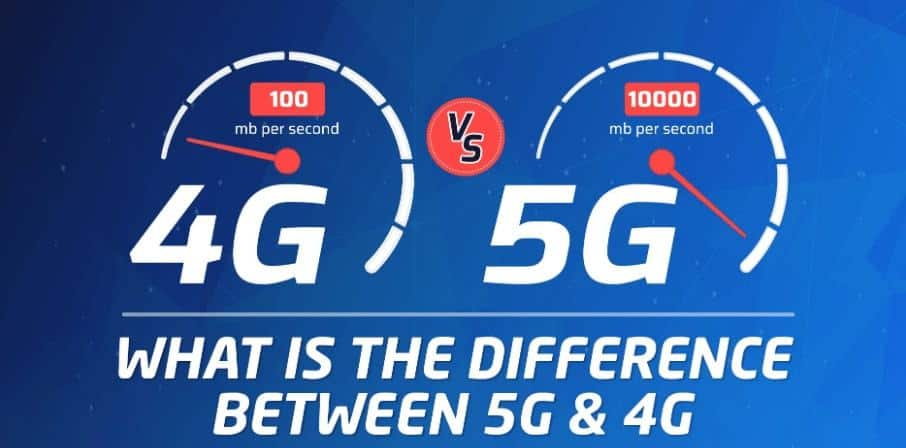4G vs 5G - What Are All Differences
As mobile market penetration hits an all-time high, data has become the new oil of our generation. With data consumption skyrocketing, the industry is scrambling to tackle network congestion of existing spectrum bands to keep up with our need for speed.
You may often have experienced such breakdowns in service, especially in highly crowded areas where tons of other people are trying to access online mobile services simultaneously.
Hailed as a gamechanger for next-generation mobile connectivity, 5G marks another great leap forward in data download and upload speeds. 5G promises to nurture the roots of existing infrastructure and set the stage for faster speeds, capacity, low latency, and quality like never before.
So what makes the 5G network a true gamechanger?
Let’s learn what is 5G, the evolution of wireless technology and how 5G compares to 4G networks.
SHARE THIS IMAGE ON YOUR SITE

What is 5G?
5G is poised to be the backbone of the IoT (Internet of Things) economy that will connect virtually everyone and everything.
Whether it’s mobiles, equipment sensors, drones, or any other smart devices, 5G can easily lubricate our data highway so that speed limits barely matter and millions of devices can access data without a hitch.
The greater connectivity offered by 5G network coverage will enable machine-to-machine (M2M) communication and profoundly impact every industry from banking to healthcare. Innovations such as drone package deliveries, self-driving cars, remote surgeries, telemedicine, etc. will soon become highly feasible thanks to the 5G network.
The Evolution of Wireless Technology – From 1G to 5G
In the last four decades, nothing has evolved as dramatically as mobile communication technology. Many of us fondly remember marvelling at our 2G Nokia 3310 device playing Snake and wondering how good can this ever get.
Let’s take a walk down memory lane and track the evolution of wireless technology:
1G
Initiated in 1979, 1G marked the first generation of telecom networks that allowed us to communicate on the go. However, it suffered from severe coverage and sound quality issues. You could not find any roaming support between different operators since their systems operated on unique frequency ranges.
Even the corporations that could afford to use it were turned off by the major flaw in communication security. Since the calls were not encrypted, you could spy on a call just by using a simple radio scanner.
2G
Introduced under the GSM standard, 2G networks marked a shift from analogue to digital radio signals. Although it seems ancient to us now, 2G was the bedrock of the cultural revolution that followed this jump in mobile network tech.
Some of its key features include:
- Data speeds nearing 64 kbps.
- Initiated services like SMS and MMS for the first time.
- Provided secure encrypted standards and significantly clearer audio quality during calls.
- Operated on a bandwidth of 30-200 kHz.
3G
Upgrading its core through the Universal Mobile Telecommunications System (UMTS) standard, 3G retained much of what the 2G spectrum did successfully and focused on providing a more reliable mobile internet experience. It depended on packet switching to achieve this.
Some of the key features of 3G include:
- Data speeds nearing 2 Mbps.
- Greater bandwidth and data transfer rates.
- Ability to send and receive large email messages.
- Achieved increased call clarity by operating at a greater range on a bandwidth of 15-20 MHz.
4G
First launched as the 4G LTE standard in 2009, it leveraged key technologies like MIMO (Multiple Input Multiple Output) and OFDM (Orthogonal Frequency Division Multiplexing). 4G marked the biggest jump in mobile internet speeds that levelled the playing field for customers to truly tap into the “smart” aspect of their smartphone device.
Some of the key features of 4G networks included:
- Provides support for interactive multimedia, voice, and video.
- A 4G phone could now achieve data speeds of up to 20 Mbps or more while lowering the cost per bit.
- Improved global scalability of mobile network coverage.
- Supports ad hoc and multi-hop networks.
5G
Just on the verge of taking off, 5G networks promise to go far beyond broadband wireless services to facilitate IoT and other vital communication segments. Using a combination of small cells (carriers using millimetre wave) and beamforming, 5G networks can offer phenomenally fast with low latency.
Some of its key features include:
- Offering faster speeds up to 10 Gbps, which is over 10 times faster than 4G performance.
- Offers remarkably low latency possibly 60-120 times faster than current 4G latency.
- Operates on a bandwidth of 30 GHz to 300 GHz.
Comparing the differences between 4G and 5G networks
As 5G seems primed to fill the market gaps that 4G could not and usher a digital economy revolution, it’s essential to understand the critical differences between 5G and 4G network.
4G | 5G | |
Latency | 60 to 98 ms | Less than 1 ms |
Potential download speeds | 100 Mbps – 1 Gbps | 10 Gbps |
Base stations | Cell towers | Small cells |
OFDM encoding | 20 MHz channels | 100-800 MHz channels |
Cell density | 200-400 users per cell | 100 times greater than 4G |
5 Pros of 5G Technology
- Higher Transmission Speeds (5G is at least 10-100 times faster than 4G LTE)
- Reduced Latency (5G offers 10 times lower latency than 4G )
- Greater Connectivity (5G allows a 100 times boost in traffic capacity)
- Increased Energy Efficiency (5G network can potentially lower energy consumption by 10% unlike existing 4G LTE networks)
- Better coordination of business processes (Through 5G technology, enterprises can coordinate devices under with much higher efficiency.)
5 Major Cons of 5G Technology
- Expensive 5G infrastructure establishment costs (replacing current mobile infrastructures, requires a lot of base stations and skilled workers for maintenance)
- Uncertainty of success (5G tech is still wearing its training wheels and a lot more testing has to be done to understand its feasibility)
- Limited 5G coverage (Waves in the 5G spectrum – millimetre waves, possess a really low penetrating power and are unable to penetrate through buildings, trees, walls, etc. without disruption in service)
- Currently operating in highly overcrowded radio frequency bands (Many 5G networks are now running on 6 GHz, which is already crowded with other signals)
- Security and privacy Issue (exponential increase in devices transmitting and accessing high-quality data on the 5G spectrum provides more entry points for hackers)
Interesting facts
- Do you know the main difference between 4G and 5G? Basically, 4G is introduced to enhance the internet download speeds and 5G is developed to control electronic devices.
- According to the Ericsson Mobility Report, at least 65% of the world’s population will have used 5G by 2024.
- 5G networks will play a key role in actualizing the goals of big data, artificial intelligence, robotics and the IoT a great deal.
- Current Virtual Reality and Augmented Reality users often complain about nausea whenever the latency goes above 20 ms. However, with 5G’s excellent low latency, the download speeds and user experience will be flawless.
- The first country to complete 5G rollout on a massive scale was South Korea in 2019.
Conclusion
Although the evolution of 1G to 4G network was mainly about optimizing wireless network technology and perfect our smartphone, 5G’s aspirations are too big to be contained to the world of smartphones alone.
Access to the 5G spectrum is not just about faster download speeds for our streaming needs, but about becoming the bridge for the internet, cloud and distributed computing industries to build a connected economy like never before.
When you’re driving a smart car, piloting a drone, or remote controlling a robotic surgical tool, every millisecond is critical to execute your command efficiently. With 5G speeds going supernova, we can expect a massive improvement in the ability of our devices to accurately calculate, analyze sensory data, and complete a lot more data-intensive tasks in a short time.



